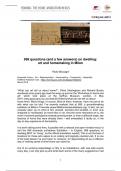999 questions (and a few answers) on dwelling:
art and homemaking in Milan
Paolo Boccagni
Keywords: Home – Art – Representation – Homemaking – Temporality – Hospitality
HOMInG Fieldwork note - https://homing.soc.unitn.it/category/fieldwork/
March 2018
“What can art tell us about home?”, Olivia Sheringham and Richard Baxter
wondered some years ago (see the wrap-up post on the “Workshop on home and
art” which took place at the Geffrye Museum, London, in May
2015: www.geog.qmul.ac.uk/news/2015/items/what-can-art-tell-us-about-
home.html). Many things, of course. Most of them, however, have not just to do
with what can be told. I’ve recently realized that at 999, a groundbreaking
exhibition at Milan’s Triennale (www.999domandesullabitare.org). In fact, art can
uniquely open up on what is felt, sensed, touched and smelled, or even only
imagined or recollected, as home-like or not. And the more interactive art is, the
more it reorients participants towards sensing anew, or from a different angle, key
features of home that were already there – well embedded, if tacitly so, in the
day-to-day experience of domesticity.
It is worth taking some time, if possible with a relaxed and open-minded mood, to
visit the 999 domande sull’abitare Exhibition – in English, 999 questions on
dwelling [NOT on “living”, as the official translation reads!]. This is not the best of
locations for those who aspire to an orderly and logically oriented visit. It is one
of the best places I’ve ever been to, however, for appreciating art as a reflexive
way of making sense of what home can stand for.
Out of an evolving assemblage or fifty or so installations, with new side events
every day, I can only pick up and write down some of the many suggestions I had
1
, as I was wondering around. Just some fragments of a narrative, out of the million
different ones that a good exhibition can elicit. Sort of ex-post ethnographic notes
– something different, and more theoretically driven and selective, than a mere
list of exhibits. I’m going to do so in a present tense, less as a way of “freezing
observation” than as a way of recognizing the context-dependency of this post.
In fact, it mirrors my own reactions vis-à-vis the installations, as I was facing them.
The pictures I’ll comment are, of course, my own.
Getting in, sharing, hosting
As one gets into the exhibition, the first stop is necessarily in a dark space packed
with micro-screens hanging down from the ceiling. On each of them, one
changing question about home. “What happens at home while you’re not there?”
(pic. 1) is the first that leaves some trace in my memory, and in the one of my
mobile phone. Not so sure that nothing is, or should be, the right answer. Still
another question looks more impressive, though: “Is there any instruction manual
for home?” (pic. 2). After all, homemaking has all to do with the absence of such
a manual – with the blessing and curse of having to make oneselves at home
anew, from scratch, in any domestic environment, as long as there is one.
2




